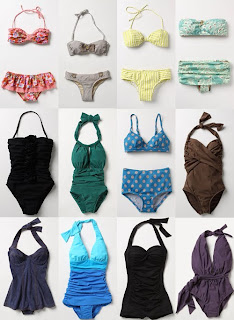 However, there is no evidence that this was used for swimming. All classical pictures of swimming show nude swimmers.
However, there is no evidence that this was used for swimming. All classical pictures of swimming show nude swimmers.In various cultural traditions one swims, if not in the nude, in a version in suitable material of a garment or undergarment commonly worn on land, e.g. a loincloth such as the Japanese man's fundoshi In the United Kingdom until the mid-19th century there was no law against nude swimming, with each town being free to make its own laws. For example, the Bath Corporation official bathing dress code of 1737 prescribed, for men:
It is Ordered Established and Decreed by this Corporation that no Male person above the age of ten years shall at any time hereafter go into any Bath or Baths within this City by day or by night without a Pair of Drawers and a Waistcoat on their bodies.

In rivers, lakes, streams and the sea men swam in the nude, where the practice was common. Those who didn't swim in the nude, stripped to their underwear. The English practice of men swimming in the nude was banned in the United Kingdom in 1860. Drawers, or caleçons as they were called, came into use in the 1860s. Even then there were many who protested against them and wanted to remain in the nude. Francis Kilvert described men's bathing suits coming into use in the 1870s as "a pair of very short red and white stripped drawers".
Female bathing costumes were derived from those worn at Bath and other spas. It would appear that until the 1670s nude female bathing in the spas was the norm and that after that time women bathed clothed. Celia Fiennes gave a detailed description of the standard ladies' bathing costume in 1687:

The Ladyes go into the bath with Garments made of a fine yellow canvas, which is stiff and made large with great sleeves like a parson’s gown; the water fills it up so that it is borne off that your shape is not seen, it does not cling close as other linning, which Lookes sadly in the poorer sort that go in their own linning. The Gentlemen have drawers and wastcoates of the same sort of canvas, this is the best linning, for the bath water will Change any other yellow.
The Bath Corporation official bathing dress code of 1737 prescribed, for women:
 No Female person shall at any time hereafter go into a Bath or Baths within this City by day or by night without a decent Shift on their bodies.
No Female person shall at any time hereafter go into a Bath or Baths within this City by day or by night without a decent Shift on their bodies.The Expedition of Humphrey Clinker was published in 1771 and its description of ladies’ bathing costume is different to that of Celia Fiennes a hundred years earlier:
The ladies wear jackets and petticoats of brown linen, with chip hats, in which they fix their handkerchiefs to wipe the sweat from their faces; but, truly, whether it is owing to the steam that surrounds them, or the heat of the water, or the nature of the dress, or to all these causes together, they look so flushed, and so frightful, that I always turn my eyes another way.
Penelope Byrde points out that Smollett’s description may not be accurate, for he describes a two-piece costume, not the one piece shift or smock that most people describe and is depicted in contemporary prints. His description does, however, tally with Elizabeth Grant’s description of the guide’s costume at Ramsgate in 1811. The only difference is in the fabric the costumes are made of. Flannel, however, was a common fabric for sea bathing costumes as many believed the warmer fabric was necessary in cold water.

In the 18th century women wore "bathing gowns" in the water; these were long dresses of fabrics that would not become transparent when wet, with weights sewn into the hems so that they would not rise up in the water. The men's swim suit, a rather form-fitting wool garment with long sleeves and legs similar to long underwear, was developed and would change little for a century.
In the 19th century, the woman's two piece suit became common—the two pieces being a gown from shoulder to knees plus a set of trousers with leggings going down to the ankles.